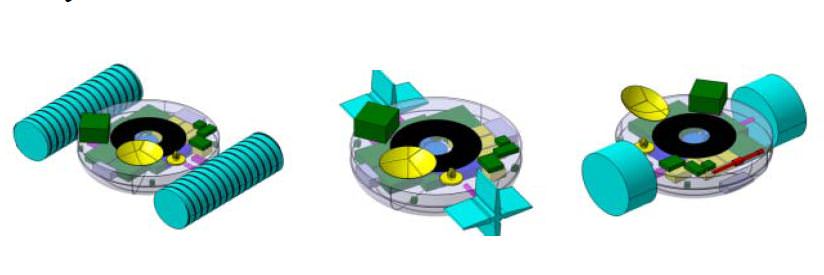Three concepts for the TALISE boat mission to Titan: screw propelled (left), paddle wheels (center) and inflatable wheels (right). Credit: Urdampilleta, et al.
Is sending a boat to Titan an outlandish idea? Maybe, said a group of European scientists and engineers, but they're working on a plan. The Titan Lake In-situ Sampling Propelled Explorer (TALISE) proposes a sending an instrument-laden boat-probe to Saturn's largest moon that could be propelled by paddles, inflatable wheels or screws. The probe would land in the middle of Ligeia Mare – Titan's biggest lake, near the moon's north pole -- then set sail for the coast, taking scientific measurements along the way.
"The main innovation in TALISE is the propulsion system," says Igone Urdampilleta from
SENER
, an engineering company in Spain and a member of the TALISE team. "This allows the probe to move, under control, from the landing site in the lake, to the closest shore. The displacement capability would achieve the obtaining of liquid and solid samples from several scientific interesting locations on Titan's surface such as the landing place, along the route towards the shore and finally at the shoreline."
In a
presentation at the European Planetary Science Congress
on September 27, 2012, the TALISE team says that since Titan has a thick atmosphere, a diameter between that of Earth and the planet Mercury, and a network of seas, lakes and rivers, it is in many respects more like a planet than a moon.
And it's time to go there and do a little in-situ science. The principle objective of the mission would be to characterize Titan's environment and the chemical composition of the lakes and terrain.
While the Cassini-Huygens mission landed the Huygens probe on Titan in 2005, it transmitted data for only about 90 minutes after touchdown. The TALISE mission would last six months to a year.
Images from the Cassini mission show river networks draining into the lakes in Titan's north polar region. Credit: NASA/JPL/USGS
The Cassini orbiter has confirmed that lakes, seas and rivers of liquid hydrocarbons cover much of the Titan's northern hemisphere, and these hydrocarbons may rain down on the surface, forming the frigid liquid bodies. With surface temperature at -178 degrees Celsius (-289 degrees Fahrenheit), Titan's environment is too cold for life as we may know it, but its environment, rich in the building blocks of life, is of great interest to astrobiologists, the team said.
"The chemical composition of the lakes of Titan is still not well determined," the TALISE team wrote in their
abstract
. "The detection of other compounds and the investigation of influence of both, photochemistry and the atmosphere on the chemical composition of liquids of Titan lakes remain challenging in the absence of in situ measurements. Therefore, it is next step to understand the Titan lakes environment, its relationship with the climate behavior, the surrounding solid substrate and analyze the organic inventory including the possibility of prebiotic compounds."
The actual configuration of the boat is still under consideration, and they are considering various in-situ propulsion methods through the liquid hydrocarbon seas. In addition to paddle wheels, screw propulsion and inflatable wheels, they are also looking at tank wheels, air propeller, liquid propeller and a hovercraft design.
The TALISE concept is being developed as a partnership between SENER and the Centro de Astrobiología in Madrid, Spain, and the mission is still in the very early stages of feasibility studies and preliminary mission architecture design, but they are hoping to be ready for a future space science mission call for proposals.
Sources:
EPSC
,
TALISE team abstract
 Universe Today
Universe Today
